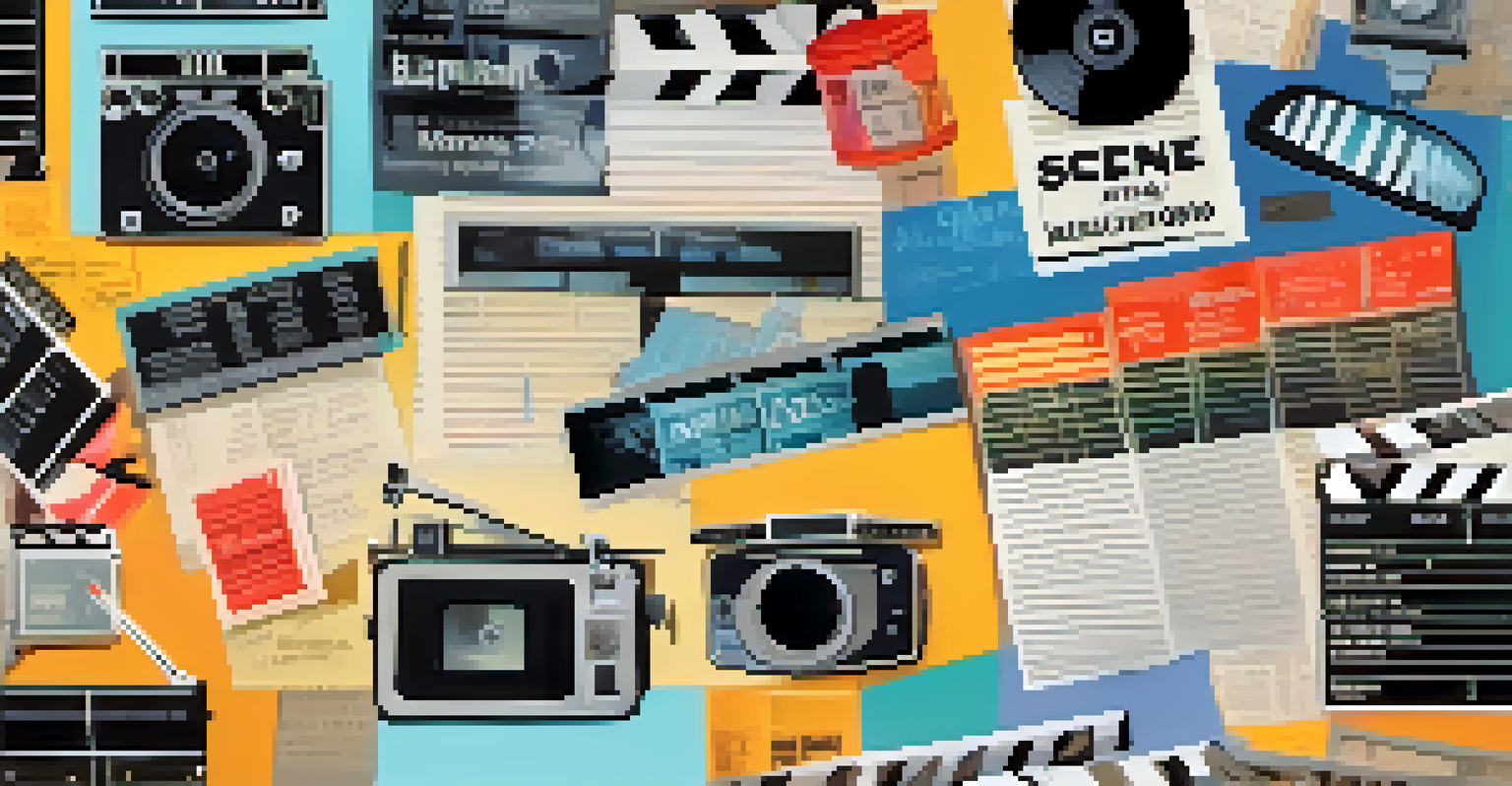The Rise of Video Essays in Film Criticism and Culture

Understanding Video Essays: What Are They?
Video essays are a unique blend of visual storytelling and analytical commentary. They typically combine film clips, voiceovers, and text to explore themes, characters, and cinematic techniques. This format allows creators to dissect films in ways that traditional written essays often cannot, offering a richer, more immersive experience.
Video essays allow for a deeper exploration of cinema that traditional criticism often overlooks.
Imagine watching a movie followed by an engaging discussion that highlights its nuances, all while enjoying relevant clips. That’s the essence of a video essay. They can vary from deep dives into a specific film to broader explorations of genres or trends within cinema.
As the digital landscape evolves, video essays have emerged as a compelling alternative to conventional film criticism. They cater to today’s audiences who often prefer visual content, making complex ideas more digestible and engaging.
The Evolution of Film Criticism
Film criticism has undergone significant transformations, especially with the advent of the internet. In the past, critics primarily relied on written reviews in newspapers or magazines, often limited by space and format. With the rise of online platforms, critics began to explore more dynamic ways to express their insights.

The transition from print to digital opened doors for varied voices and styles in film analysis. Video essays emerged as a natural progression, allowing critics to showcase their creativity while providing in-depth commentary. This shift reflects a broader cultural change towards multimedia consumption.
Video Essays Redefine Film Criticism
Video essays blend visual storytelling with analytical commentary, offering a more immersive way to explore cinema than traditional written critiques.
Today, video essays stand at the forefront of film criticism, blending analysis with artistry. They not only critique films but also celebrate the medium itself, enriching the viewer's understanding and appreciation of cinema.
Why Video Essays Resonate with Audiences
One of the primary reasons video essays have gained traction is their accessibility. Viewers can easily find and watch these essays on platforms like YouTube, making film criticism more approachable. This democratization of film commentary invites a wider audience to engage with cinema on a deeper level.
The power of video essays lies in their ability to blend analysis with visual storytelling, making complex ideas easily digestible.
Additionally, video essays often employ visual elements that enhance the storytelling aspect of analysis. By incorporating clips, stills, and graphics, creators can illustrate complex ideas in a way that feels more relatable and entertaining. It’s like having a knowledgeable friend guiding you through the intricacies of your favorite films.
The emotional connection that video essays foster is another significant factor. The combination of visuals, sound, and personal narrative can evoke feelings that written text may not convey as effectively, making the experience more memorable for viewers.
The Role of YouTube in Popularizing Video Essays
YouTube has been instrumental in the rise of video essays, providing a platform where creators can share their work with a global audience. This accessibility has led to a surge in content, allowing diverse voices to contribute to film analysis. Many creators have built substantial followings, proving that audiences crave thoughtful, engaging film discourse.
The platform's algorithm also plays a role in promoting video essays. Viewers who watch film-related content are likely to be recommended more essays, creating a ripple effect that boosts visibility and engagement. This organic growth fosters a community of film lovers eager to explore and discuss cinema.
YouTube Fuels Video Essay Growth
The rise of YouTube has provided a platform for diverse voices in film analysis, making video essays accessible to a global audience.
Moreover, YouTube’s interactive features, such as comments and likes, allow viewers to engage directly with creators. This interaction adds another layer to the experience, as audiences can share their insights and opinions, creating a dynamic conversation around the films being analyzed.
Notable Creators and Their Impact
Several creators have made significant contributions to the video essay landscape, each bringing their unique perspectives and styles. Channels like 'Nerdwriter1' and 'Every Frame a Painting' have set high standards for analysis, captivating audiences with their insightful takes on film.
These creators have not only elevated the art of video essays but have also inspired countless others to explore this format. Their ability to blend humor, emotion, and analysis resonates with viewers, proving that film criticism can be both entertaining and enlightening.
The impact of these creators extends beyond just their individual channels; they have fostered a community where critical thought about cinema thrives. Their work encourages others to engage with films more deeply, sparking discussions and promoting a culture of thoughtful analysis.
Challenges Faced by Video Essayists
Despite their growing popularity, video essayists face various challenges in their craft. One major hurdle is the issue of copyright; using clips from films can lead to complications with content ownership. Many creators navigate this by employing fair use principles, but it remains a gray area that can deter new entrants into the field.
Additionally, crafting a compelling video essay requires significant time and effort. Balancing research, editing, and storytelling can be daunting, especially for solo creators. This level of commitment can discourage talented individuals from pursuing video essays as a viable form of expression.
Challenges for Video Essay Creators
Video essayists face hurdles like copyright issues, time commitments, and the need for innovation in a saturated market.
Finally, as the landscape becomes more saturated, standing out among countless creators is increasingly difficult. Video essayists must continuously innovate and refine their approach to maintain audience interest and ensure their voices are heard.
The Future of Video Essays in Film Culture
The future of video essays appears bright as they continue to evolve alongside changing media consumption habits. As more viewers gravitate towards visual content, video essays are likely to become an integral part of film culture, offering innovative ways to engage with cinema.
We might see an increase in collaboration between video essayists and filmmakers, leading to unique insights and perspectives that bridge the gap between creation and criticism. Such partnerships could enhance the depth of analysis and provide audiences with a richer understanding of the films they love.

Ultimately, video essays represent a new frontier in film criticism, one that values creativity, accessibility, and community engagement. As they gain traction, they will likely shape the way audiences perceive and engage with cinema for years to come.